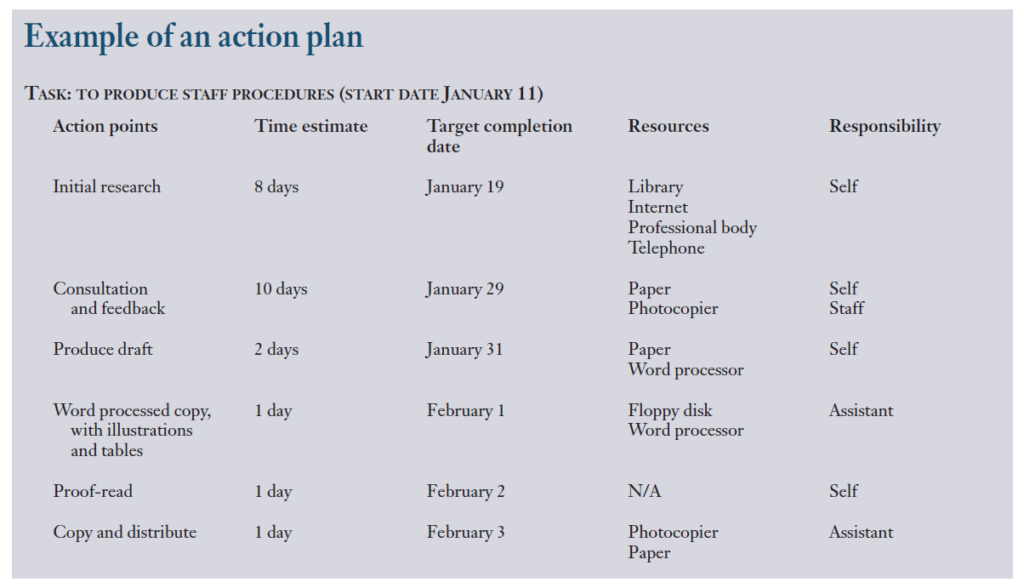
Time management is the key to meeting successfully the challenge of new, time-consuming initiatives (such as emergency hormonal contraception supply) and to addressing daily impositions on time. Time management is about developing a different mind set — thinking about time as a resource or commodity that, if not managed, will be wasted. The main benefits of effective time management are increased productivity, reduced stress levels and the highlighting of real priorities.
Time analysis
Given that time is a precious resource that has to be invested, there has to be some accountability as to how it is spent. An activity log is one mechanism that can be used to analyse expenditure on time. An activity log can be used to:
- Monitor how each hour of the day is spent
- Identify the most productive times of the day
- Identify the least productive times of the day.
Taking the analysis a step further, an activity log could be used in conjunction with salary per annum to analyse the cost of time spent on various activities at work and to make judgements about priorities. A thorough analysis of how time is being spent should highlight the most productive hours of a working day.
People are often classified as being “morning” or “afternoon” types, depending on when their energy levels are at a peak. Work should be arranged, as much as possible, around these high and low energy periods. For example, work that is intellectually demanding, or requires problem solving skills or creativity, should be undertaken during high energy level periods. More routine or mundane work that requires little concentration or intellectual input should be scheduled for low energy periods.
Taking breaks between long periods of work that require concentration can help to boost energy levels.
Goal setting
The first step to managing time effectively is to identify both work and life goals. Examples of goals might be “to spend more time on leisure activities”, “to gain a promotion” or “to become more skilled in a particular aspect of work”. Rather than just thinking about goals, it helps to write them down — committing goals to paper reinforces their significance and helps to store them in the memory.
It is important to set goals that are realistic, specific and achievable. Goals based on improving skills or knowledge are more likely to be achieved than those that have a fixed outcome. For example, setting “to get the job of a lifetime” as a goal is probably unrealistic. Better goals would be “to write better job applications” or “to be more prepared for interviews”, as these are things that can be controlled. Being specific about goals makes it easier to track and measure progress.
Setting a goal also involves identifying the resources, time, support and knowledge that will be needed to achieve the goal. It is also important to consider strategies for overcoming barriers to achieving any goal.
Once goals have been set, the next step is to identify priorities. These are the things that have to be done either to achieve a goal or to get through the necessary tasks of a working day. The best way to define priorities is to draw up a list of activities and tasks that are either urgent or important. For example, an urgent activity might be to help customers who need immediate clinical advice. An important activity might be stock taking.
Action planning
Action planning helps to focus the mind on how to achieve tasks. A plan may cover days, weeks or even months (see example below). According to the Pareto principle it often takes 80 per cent of effort to produce 20 per cent of results. An action plan helps to redress the balance, so that more can be achieved with less effort.
Because this is a plan rather than just an idea, it requires details, such as:
- What action needs to be taken?
- How much time will it take?
- When does it need to be completed?
- What resources are needed?
- Who should be involved?
Delegation
Many pharmacists find themselves doing a range of jobs that are not necessarily clinical tasks — for example, selling consumer goods or completing paperwork. Pharmacists who are owner managers of a shop may find themselves overwhelmed with paperwork.
However, for any pharmacist, once goals and priorities have been reviewed, it may be necessary to reduce the time spent on various types of non-professional activity. In many cases it might be possible for some of these tasks to be carried out competently by technicians, or other staff, who would probably welcome the opportunity to take on more responsibility.
The process of delegation is based on the assumption that, within a pharmacy, there are competent staff to whom tasks can be delegated. If members of staff are not deemed to be competent, then training and development could help them progress and reach a standard at which they can take on delegated tasks. Training is an additional cost and can be in-house or external but the cost has to be weighed against the benefits and advantages of being able to spend more time on professional activities.
Delegation works best when it is seen to be part of a strategy rather than just a means of dumping work on someone else. If used strategically, passing on work can be used to develop, train and motivate staff. The process should begin with a list of work that can be delegated. Next, the nature of the tasks and the knowledge, skills and time required to complete them should be outlined. The final step is to match tasks to be delegated to the most appropriate person.
When passing on work, communication with the person to whom the task has been delegated is essential. Some time will have to be invested in support before the delegated task is “owned” completely by another member of staff. Attempts to reclaim the task can leave staff feeling demoralised or undermined, so it is important to let go once the task has been delegated. However, reviewing or periodically checking on progress is appropriate, as it provides an avenue for support, if required.
Common time wasters
Meetings
One of the great time wasters in organisations and companies is meetings that are unnecessary or badly organised.
Meetings cost both money and time, which is why the fundamental question must always be asked — is holding a meeting necessary? It is important to consider whether other forms of communication will achieve the same objectives at a fraction of the cost. If the meeting is necessary, then, in order to be productive, it needs to be planned and scheduled with a clear agenda, which is distributed in advance, together with any necessary papers.
Meetings should always have a clear timetable and agenda, which should be respected by the chairman and the participants. In addition, only those people who need to attend should be invited. As the meeting progresses, action points should always be identified and agreed upon, so that the meeting is seen to have clear objectives. Individuals should subsequently leave the meeting with a clear understanding of decisions made, action they need to take and deadlines.

Time management checklist
- Set goals and priorities
- Eliminate time-wasting activities
- Plan and schedule time
- Delegate, where possible
- Use time productively
- Make good use of time management tools, as appropriate
- Get organised
Conferences are, perhaps, a little more difficult to assess in terms of usefulness but, in order to make the most of the time spent at a conference, preparation is vital. This includes identifying major contacts in advance — people such as workshop leaders, conference speakers and other contacts who will be useful for networking and/or staff development purposes. The return on time spent at conferences is also maximised by:
- Arranging in advance to collect papers from workshops or conference sessions that coincide
- Finding out as much as possible about the purpose and target audience of the conference
- Checking thoroughly all travel and accommodation arrangements.
Disorganisation
Time wasting is perhaps the most direct, obvious and potentially most expensive consequence of disorganisation.
Simple organisation of both electronic and manual sources of information into clearly marked files and folders both saves and creates time. It is worth the investment of spending a whole day to organise into files work and information that is regularly needed and accessed. Depending on the flow and volume of information, some kind of index to where information is stored is another useful timesaving strategy.
The principles of organisation are the same both for computer and e-mail files. Hours can be wasted trying to find some inappropriately named file that is “somewhere” on the computer. File names that reflect content should be used, and related files grouped together into folders. When using the internet, “bookmark” favourite sites or sites that appear to be relevant. It is far better to do this and later delete a website address that turns out not to be interesting, than it is to spend hours trying to find it when it is really needed. Bookmarked websites can also be grouped together into folders.
Decisions should be made about the preferred medium for receiving information. For example, subscriptions to online journals mean that articles can be quickly printed off or downloaded, without the extra task of photocopying. However, online journals require a computer, which may not always be accessible.
Time management tools
One of the most simple, inexpensive and yet powerful tools is a “To Do” list.
These often appear as a section in personal planners and on email services. A To Do list is an outline of tasks that have to be achieved by the end of the day. Attaching a time limit for the completion of tasks ensures that work on one task does not encroach on time allocated for another. It also focuses the mind on achieving a task within a set time limit.
The guiding principle of the To Do list is linked to Parkinson’s law, which states that work expands to fill the time available. Reversing the law, by reducing the time available for work, or aspects of work, means that too much time is not expended on any one task. Having a To Do list maximises the potential for being productive throughout the day, even if interruptions or unexpected events occur.
Other practical time saving tools and facilities worth investigating are:
- Automatic telephone dialling
- Pagers
- Teleconferencing
- Videoconferencing
- Scanners
- Voice mail
- Mobile telephones with integrated fax, e-mail and internet facilities.
Personal planners have also come a long way over the years. Many include a range of accessories, such as the following:
- Activity lists
- Meeting planners
- Performance objective sheets
- Meeting logs
- Notation logs
- Diary section with hours divided into 10ths and quarters
- Voice mail record sheets
- Crisis preventer (a “hot list” insert for priority tasks).
Procrastination
No article on time management could conclude without mentioning procrastination.
Behaviour analysts have identified two common causes of procrastination. One is a reluctance to deal with unpleasant things. The other cause is linked to feelings of inadequacy, low self-esteem or fear of failure. For people who fear failure, or fear being perceived as a failure, procrastination is a defence mechanism. However, delaying the inevitable ultimately creates more problems, such as panic and stress, and the quality of work produced decreases. This, in turn, leads to increased feelings of inadequacy and failure.
Procrastination can take the following forms:
- Delaying tactics — extending the planning process to avoid doing the task
- Waiting for the “right” time to complete a task
- Assuming that there’s plenty of time available
- Stalling because of not knowing where to begin
- Always putting other tasks first.
The only way to overcome procrastination is not to do it. Procrastination can be reduced by the following strategies:
- Break seemingly difficult tasks into parts and complete each part in stages
- Set up a timescale and deadlines for achieving each stage
- Create a reward system, so that as each stage of task is completed a reward is earned
- Arrange for a colleague to check up on progress with tasks that are prone to being deferred
- Make an unpleasant, boring or undesirable task a priority so that at least it’s done and out of the way.
Conclusion
Becoming skilled at time management means recognising that most people work to their own priorities. Being assertive and being able to say no, therefore, is imperative when working to a time management plan.
Given that time management is not an exact science, it has to be accepted that, even with the best scheduling in the world, unexpected events will occur that have to be dealt with immediately. However, a good time management plan can accommodate change.
It is important to stress that, for both mental and physical health, time for relaxation should always be built into any time management plan.


